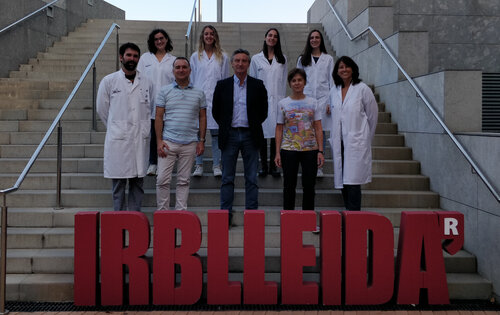The French Friedreich's Ataxia Association awards a grant of 28,000 € to the IRBLleida to understand the early stages of this rare disease
The Biochemistry of Oxidative Stress group is leading the project
The French Friedreich's Ataxia Association (AFAF) has awarded a €28,000 grant to the Biochemistry of Oxidative Stress research group at the Institute for Research in Biomedicine of Lleida (IRBLleida) and the University of Lleida (UdL) to better understand the early stages of the disease. This is the third time that the AFAF has financed a Lleida project and on this occasion, it will be used for a comparative study of mice of the I151F model to discern the early stages of the pathogenesis of Friedreich's ataxia.
"The organisation has highly appreciated the quality of the proposal," explained the principal investigator of this project, Fabien Delaspre. Friedreich's ataxia is a rare neurodegenerative disease caused by low but not zero levels of frataxin, a mitochondrial protein. The disease is characterised by a destruction of certain nerve cells in the spinal cord, the cerebellum and the nerves that control muscle movements in the arms and legs.
The IRBLleida Biochemistry of Oxidative Stress research group, led by University of Lleida professors and researchers Joaquim Ros and Jordi Tamarit, is carrying out this research entitled "Étude comparative de souris I151F pour discerner les premières étapes de la pathogenèse de l'Ataxie de Friedreich". The main objective of the project is to discover biomarkers altered by a slight decrease in frataxin using mice of the I151F model. The study aims to provide key insights into the initial and most vulnerable events of the degenerative process that will progressively evolve into the dysfunctions observed in patients. This project fits in with one of the priorities to advance the understanding of the molecular basis of this disease by addressing the initial steps and, consequently, to propose clear and well-defined therapeutic strategies.
Friedreich's ataxia usually appears between the ages of five and 15, and is often accompanied by heart disease and diabetes. "These symptoms are very difficult to reproduce in mice, as none of the mouse models developed so far have been able to successfully reproduce the main features of the disease. Our model is a good model to study Friedreich's ataxia, since homozygous mice (those with 2 copies of the mutated gene) show low, but not zero, levels of frataxin and signs of locomotor dysfunction," explained Fabien Delaspre. The research group will now look for biomarkers with heterozygous mice (formed by the union of two gametes that have different genetic constitution), those that have only one mutated copy and one healthy copy of ene. "We hope that these mice will help us to discriminate the initial events in the development of the disease," explained the researcher.
The Biochemistry of Oxidative Stress group at IRBLleida has extensive experience in this field of research. In 2017 it received international funding from the Rare Genomics Institute for the creation of this new mouse model of Friedreich's ataxia, using an innovative strategy based on CRISPR technology to introduce a point mutation present in humans in the mouse frataxin gene that causes the instability of this protein. The model was developed in collaboration with The Jackson Laboratory (USA).

The Biochemistry of Oxidative Stress group is leading the project






